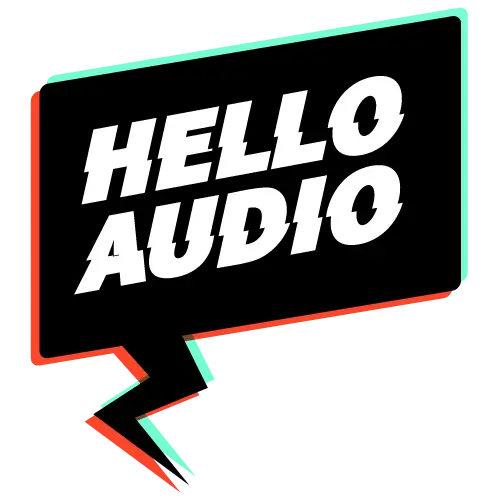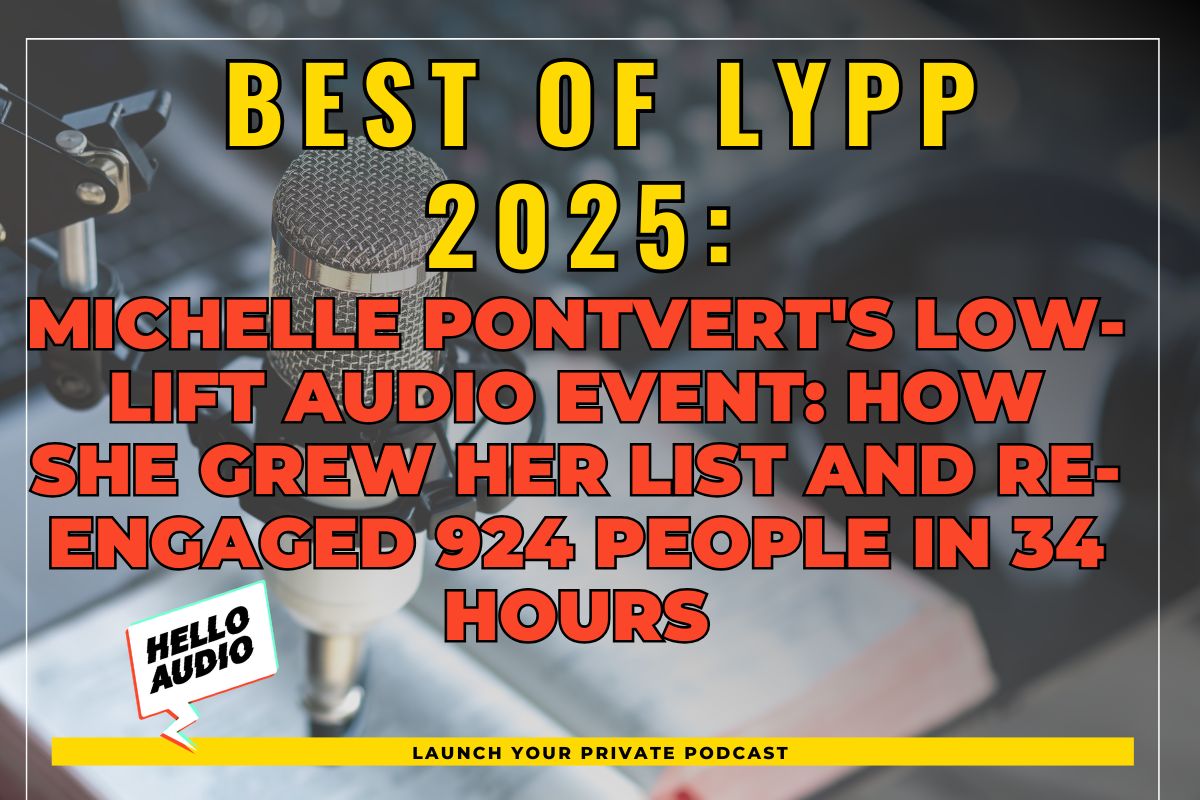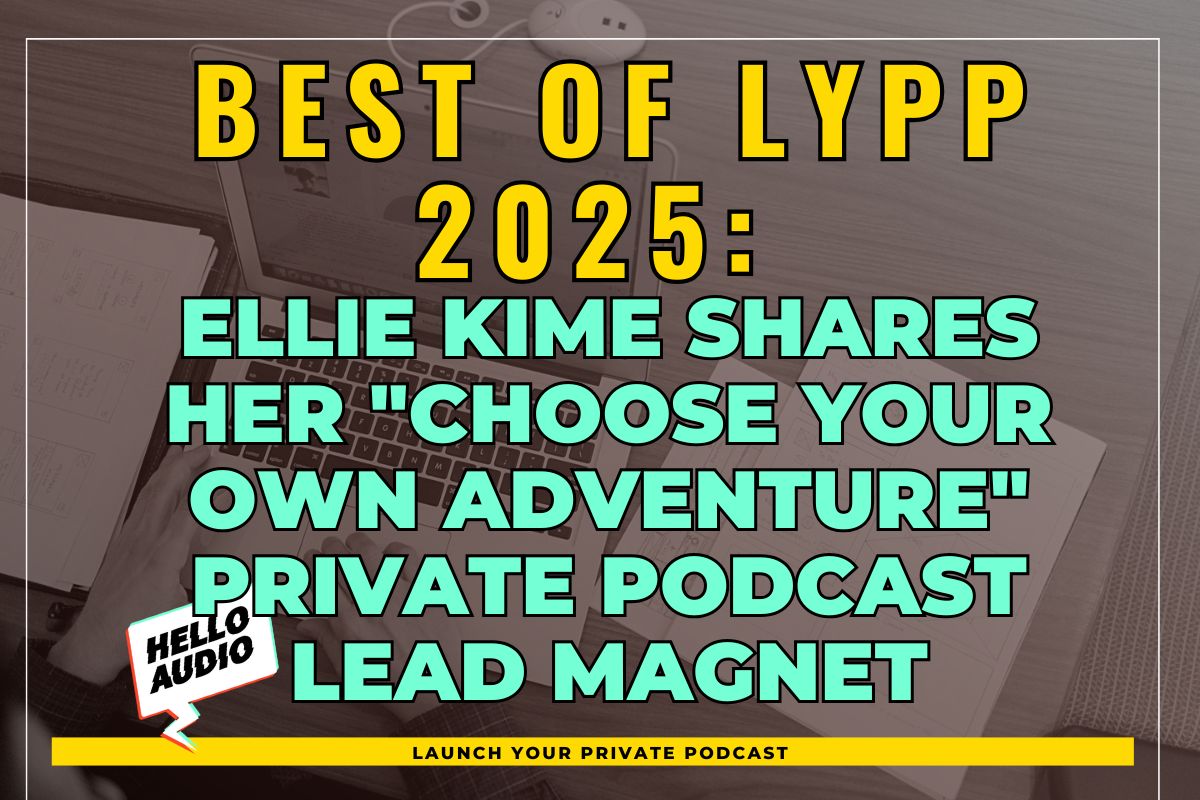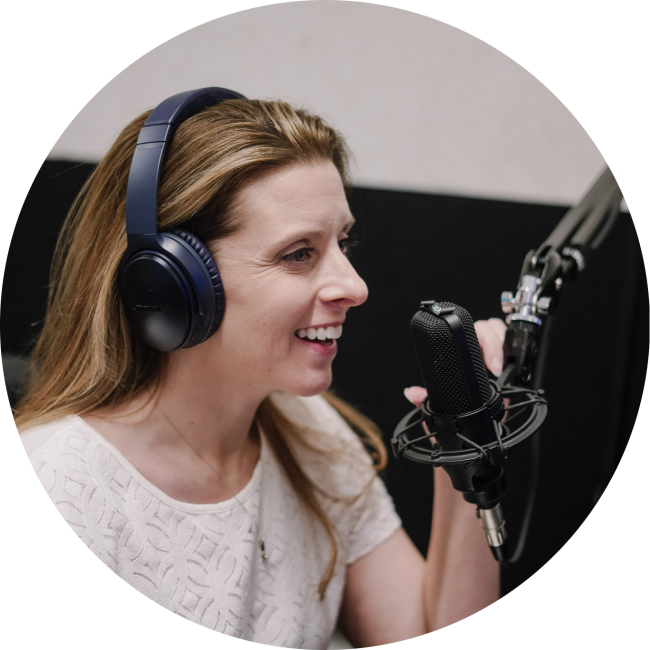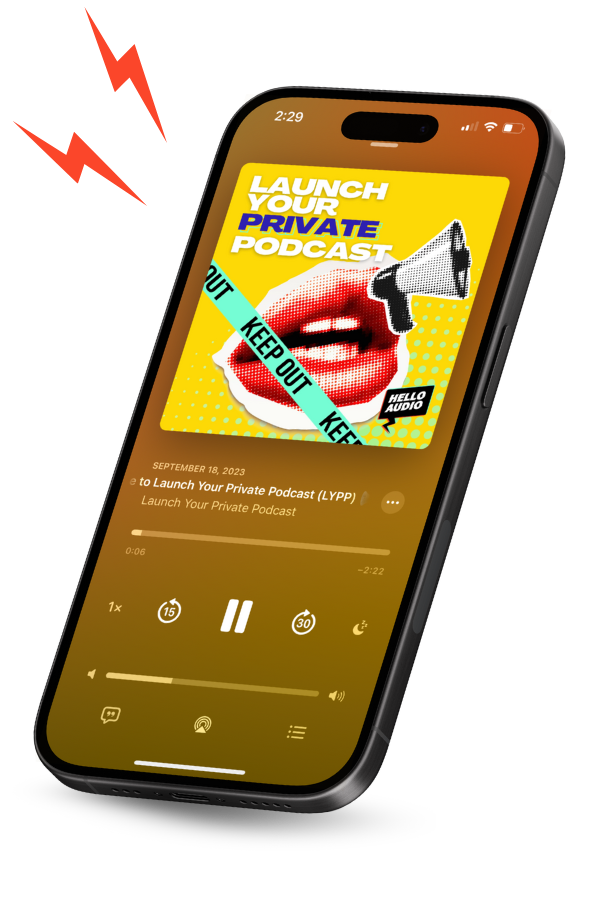The digital content market is valued at over $27 billion and is forecast to grow at about 13% year-over-year.
As such, if you are an aspiring content creator, there has never been a better time to join the industry.
Get started with the right platform to streamline your content management process.
In this article, we will highlight the best content creator platforms, provide tips on choosing the best one for you, and offer best practices to accelerate your content creation journey.
TL;DR – Top 6 Content Creator Platforms
Need a summary of what we’ve discussed in the article?
Here’s a quick overview of the best content creator platforms:
- Hello Audio
- Patreon
- Teachable
- Medium
- Ko-Fi
- Meta Business Suite
- Substack
- Notion
Looking for a platform to repurpose your existing content into audio podcasts and gain a larger listener base? Choose Hello Audio!
Our platform lets you quickly convert any existing video or audio content into private podcasts, which you can then distribute via popular platforms like Overcast, Apple Podcasts, and more.
Also, Hello Audio supports various monetization options, including creating exclusive content that is accessible only to selected members.
Sign up for Hello Audio with our 7-day free trial!

What Are Content Creator Platforms?
Content creator platforms are digital spaces where you (individuals or groups) can share, promote, and monetize your work. In this context, work includes photos, videos, vlogs, and blog posts.
At the basic level, these platforms help creators connect with their audience by providing resources for content distribution and community building.
Below are the core elements of content creator platforms:
- Production tools: recording, editing, and mastering.
- Promotion tools: email lists and integration with social media platforms.
- Monetization tools: ad insertion, affiliate links, and members’ lists.
- Advanced analytics and reports.
Types of Content Creator Platforms
Below are the most common types of content creator platforms:
- Social Media Platforms: They are suitable for sharing multimedia content to grow personal brands or enhance customer engagement.
- Video Sharing Platforms: Ideal for video content, including vlogs, tutorials, and product reviews.
- Monetization Platforms: Focused on monetizing content. Consumers pay a pre-determined amount for access.
- Blogging Platforms: Suitable for creators focusing on written content, including articles and personal blogs.
- Podcasting Platforms: They provide a platform for creators to manage and monetize their podcast shows.
- Skill-Sharing Platforms: They target educators and tutors offering online courses and tutorials.
- Niche Platforms: Cater to specific communities and interests like gaming or fitness.
- Collaborative Platforms: Provide shared workspaces, allowing creators to collaborate on the platforms.

Benefits of Using a Content Creator Platform
Below are the main incentives for using a content creator platform:
- Editing and Mastering Tools: Access to built-in editing tools to help you master your content and remove background noises to enhance the audience experience.
- Reach a Global Audience: They help bridge geographical gaps between you and your target audience, expanding your reach.
- Access Monetization Opportunities: They provide various monetization options, including ad marketplaces, sponsorships, and subscription models.
- Community Building: They double up as online community platforms, providing opportunities for building loyal fanbases.
- Advanced Analytics: Content platforms generate advanced analytics and reports to help you track performance metrics. The analytics help you improve your content strategy to maximize engagement.
- Networking Opportunities: Some content platforms organize meetups where creators can network. Other platforms support shared workspaces to enhance creator collaborations.

Key Features to Look for in a Content Platform
Here’s the thing about content platforms: most of them talk about big game. But when you start using them, it’s either too clunky to bother or too stripped down to be useful.
So what makes a platform good? These core features:
1. Content Management
Content chaos kills productivity. A smart platform provides structure through tagging systems, campaign filters, and a functional media library.
You should be able to find the right asset in seconds, not scroll through random uploads for five minutes.
2. Built-in Collaboration Tools
If you’re working with other writers, editors, designers, or creators, collaboration isn’t optional; it’s essential.
The platform should make it super simple to share files, give feedback, approve drafts, and track changes.
3. Smart Publishing and Scheduling
Once your content is ready, the last thing you want is to bounce between platforms to get it live.
A good content tool lets you schedule and push content straight to social media, blogs, newsletters, and more, all from one place. It saves time and cuts down on human error.
4. Analytics
Vanity metrics can confuse you sometimes. What you need is actual numbers that tell you what’s working and what’s not. With some platforms, you can conduct deep research and get dashboards showing engagement, click-through rates, conversions, and cost per post, so you’re not flying blind.

5. UGC and Discovery Tools
Want to repurpose content from customers or influencers? Some platforms help you pull in authentic user-generated content and tag it to your product pages.
Others now extend this to podcasts, letting you curate clips, highlight listener shoutouts, or even integrate user submissions directly into your episodes. It’s a simple way to bring your audience into the content itself while boosting reach and authenticity.
6. A Content Drafting Space
You want a clean, distraction-free writing environment with the essentials built in, including spell check, style suggestions, and commenting.
It should feel like a real workspace, not just a blank screen.
7. User-Friendly Interface
This one’s obvious but easy to overlook. If the platform takes a week to figure out, no one on your team will use it.
Pick something intuitive. You should be able to dive in without needing a 30-minute onboarding video.
8. Cost vs. Value
Don’t just go cheap, go smart. Some tools look affordable until you realize the features you need are locked behind higher plans.
Know what you need, and pick the tool that delivers without bloat.

6 Best Content Creator Platforms
Now that we have covered the benefits of using creator platforms, you might be curious to learn some suitable options.
Following extensive research, we’ve compiled a list of some of the best platforms.
1. Hello Audio
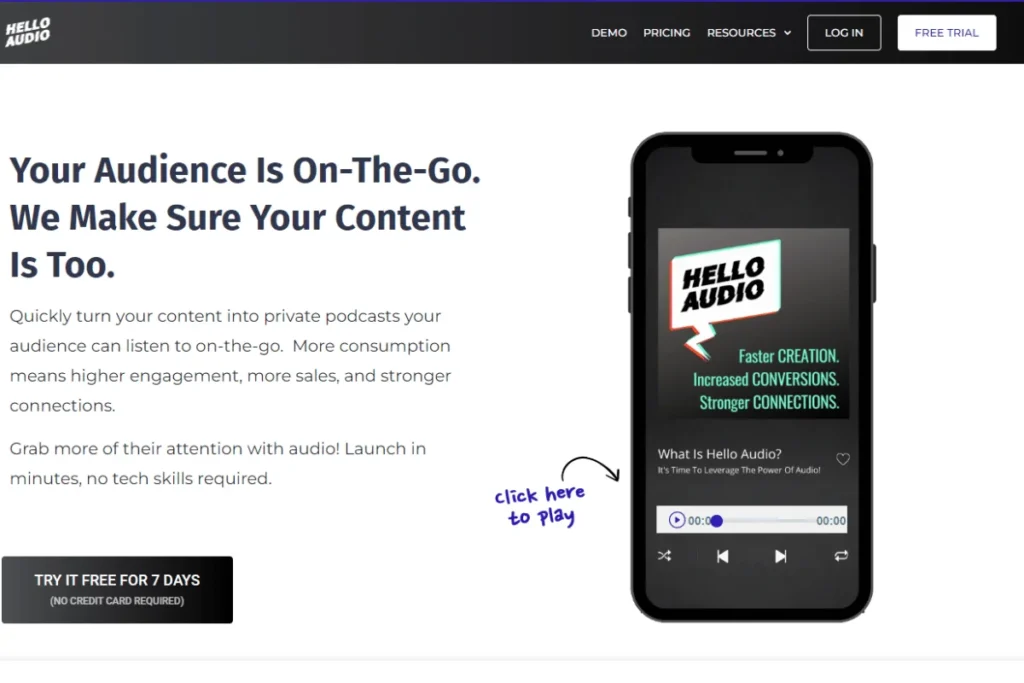
Hello Audio helps creators share their content in formats that listeners can consume on the go. This increases content consumption and fosters stronger connections with your audience, building a strong community for your brand.
Our platform also provides a centralized dashboard for managing your content, from editing and mastering to distribution and monetization.
One standout feature of Hello Audio is the built-in content repurposing tool. It lets you convert your old content, including repurposing video content into private podcasts within minutes.
Features:
- Provides editing tools to clean up audio recordings
- Helps deliver your private podcasts to platforms like Spotify
- Integrates with ConvertKit to streamline content promotion, including using automated actions to recommend content to listeners
Pricing:
- Free Trial: $0 for 7 days
- Starter: $14 per month
- Pro: $39 per month
- Powerhouse: $81 per month
Book our instant demo and learn how to unlock such benefits with Hello Audio!
2. Patreon
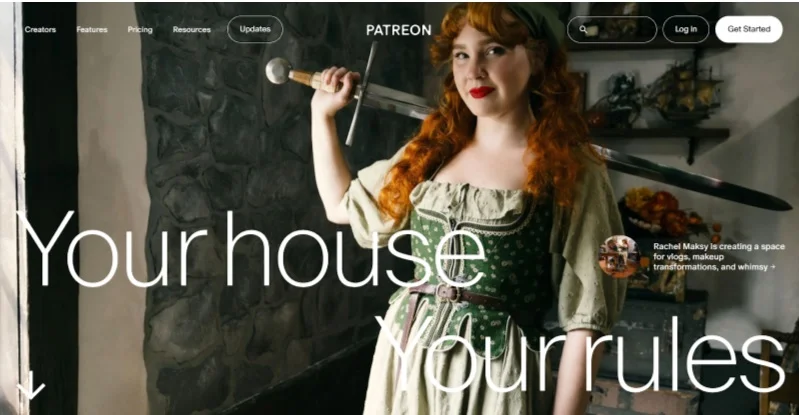
Patreon is a membership-based content platform that lets you generate revenue directly from your audience, also known as patrons.
Fans access exclusive content based on their membership tiers. Upon subscription, patrons are billed a recurrent monthly fee.
Pros:
- Direct engagement with your audience
- Supports tiered membership plans
Cons:
- Creators incur up to 12% commission fees
- Limited content editing features
Pricing:
- Free Trial: Joining Patreon is free
- Commerce: 5% of revenue
- Pro: 8% of revenue
- Premium: 12% of revenue
3. Teachable
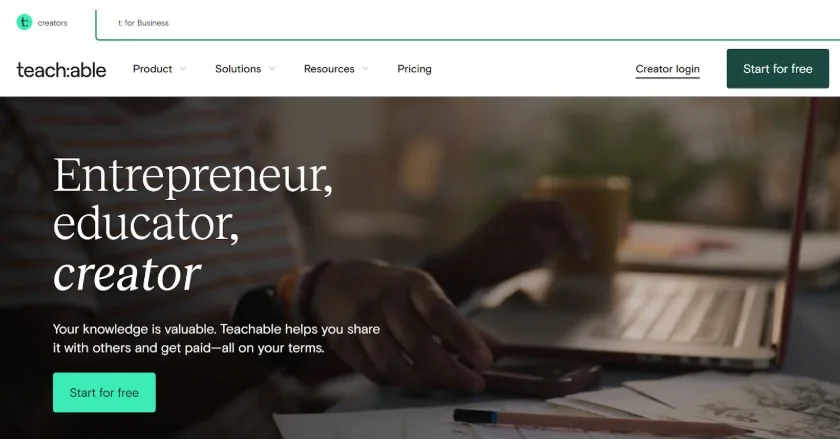
Teachable provides a platform for creators to host and sell online courses. It supports various content types, including videos, audio, and quizzes.
The platform also provides course design templates to help you make your course content dynamic and responsive for mobile users.
Pros:
- The templates simplify course creation
- You can customize learning experiences to your students’ needs
Cons:
- Expensive for creators and students, reducing course enrolment rates
- Does not provide content promotion tools
Pricing:
- Free Trial: Free plan with limited access
- Basic: $39 per month
- Pro: $119 per month
Pro+: $199 per month
4. Medium
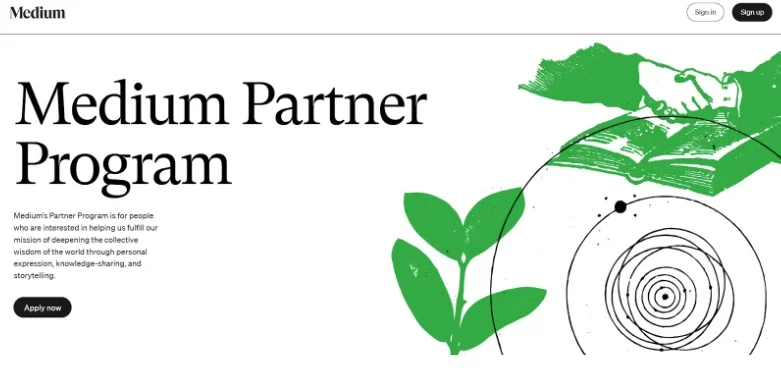
The Medium Partner Program provides a platform for creative content writers to monetize their blogs and articles.
However, unlike most platforms, Medium restricts creators from including affiliate links so they can focus on content quality.
Medium pays a commission based on reader engagement, replies, and follows.
Pros:
- Free to join
- Few monetization thresholds
Cons:
- Uses a complex revenue estimation method
- Supports limited customization features, resulting in most content layouts appearing monotonous
Pricing:
- No signup or monthly fees
5. Ko-Fi
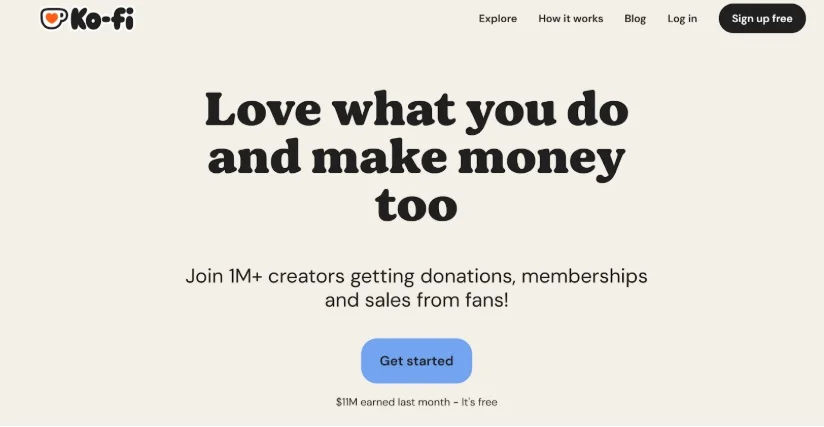
Ko-Fi is the best platform for creators to receive one-time donations for their content. In fact, the name Ko-Fi was conceptualized from the idea of loyal or satisfied fans buying a ‘cup of coffee’ for their favorite creators.
The platform’s easy setup provides an efficient way for creators to sell exclusive content.
Pros:
- Supports various content forms, including songs, drawings, images, and videos
- Doesn’t charge a monthly fee
Cons:
- Limited monetization options
- Lacks advanced content management features
Pricing:
- No sign up fee or monthly plans
- Ko-Fi retains 5% of the revenue you generate on the platform
6. Meta Business Suite
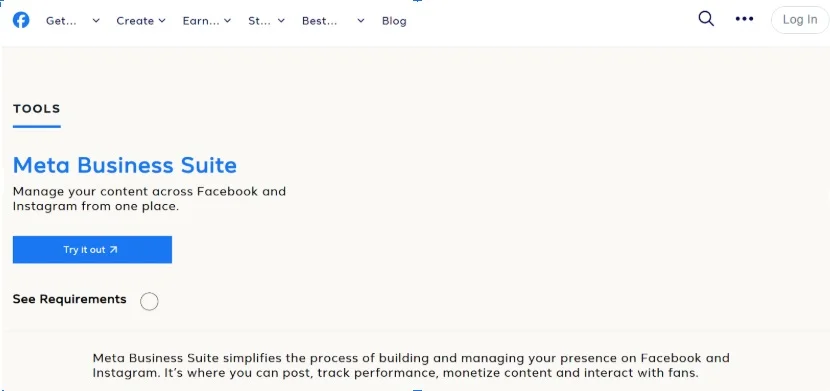
The Meta Business Suite, formerly Facebook Creator Studio, helps creators promote, distribute, and monetize their content across Facebook and Instagram.
Creators can schedule when to post content for maximum engagement, especially when targeting consumers in other time zones.
You can also leverage ads to enhance your content’s reach, as Meta broadcasts the posts to lookalike audiences.
Pros:
- Streamlines content management on Facebook and Instagram
- Access to advanced analytics to refine your content strategy
Cons:
- Complex monetization features might overwhelm beginner creators
- Limited to social media platforms managed by Meta
Pricing:
- No sign up fees
- Meta charges ads based on impressions
7. Substack
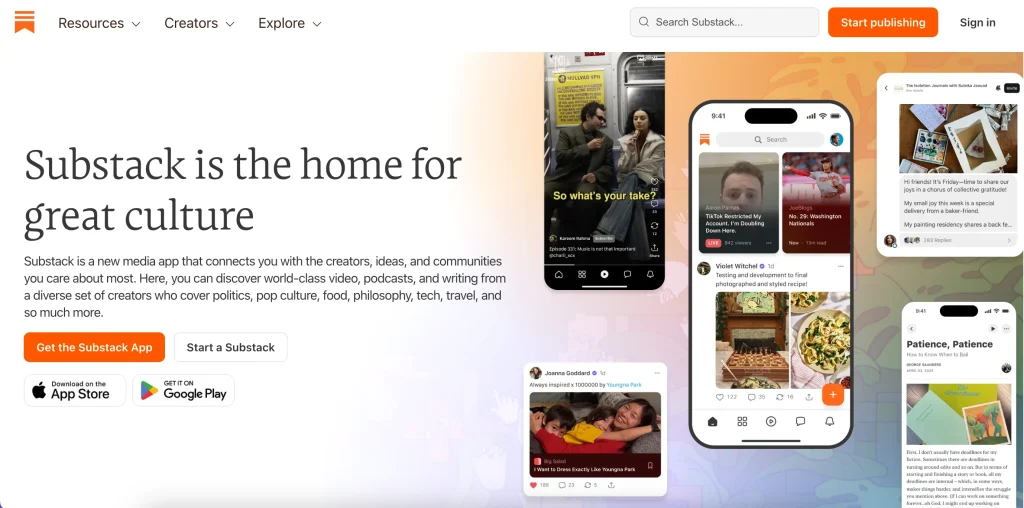
Substack makes it easy for writers to send newsletters and earn money through subscriptions. The big difference from Medium? Email is the core. Writers actually own their mailing lists, which means they control their audience and their connection.
Pros:
- Direct subscriber ownership (your email list is portable)
- Simple publishing and monetization workflow
Cons:
- Limited customization for newsletter design
- Revenue depends heavily on subscription growth
Pricing:
- Free to start
- Substack takes 10% of subscription revenue
8. Notion
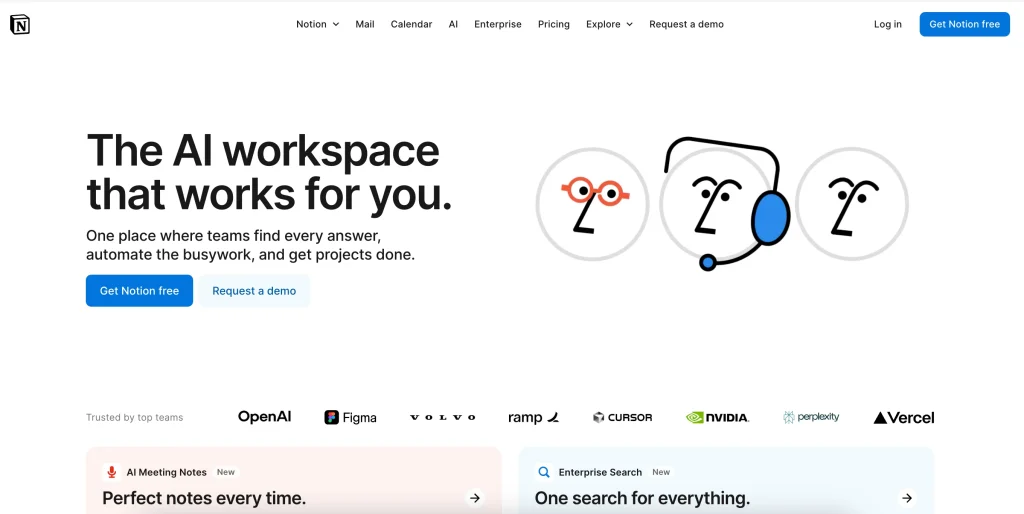
Notion has become a go-to platform for creators to package and sell digital products like templates, guides, and workspaces. Its versatility makes it popular among educators, entrepreneurs, and creators who want to share structured content.
Pros:
- Highly customizable for different content formats
- Easy to share and sell Notion templates with audiences
Cons:
- Steeper learning curve compared to simpler platforms
- Monetization requires integrations or third-party tools
Pricing:
- Free plan available
- Plus: $10 per month
- Business: $20 per month
Summary of the Best Content Creator Platforms:
| Supports collaboration on multiple projects simultaneously. Easy to integrate with analytics, marketing, and payment processing tools. | Lacks content creation or monetization features. The monthly subscription fees could be unsustainable when working with large teams. Requires integration with other tools to enhance its features. |
How to Choose the Right Platform for Your Content
Here’s a step-by-step guide for picking the right platform for your content:
- Understand Your Target Audience: Pick a platform that makes the content easily accessible to your audience, regardless of geographical location.
- Consider the Type of Content: Choose a platform that suits your content and the expected method of consumption. For example, you can pick a podcast platform for audio shows.
- Compare Platform Features: Research various platforms and pick the option whose features address your content creation needs, including editing tools and content promotion resources.
- Consider Monetization Options: Pick a platform that provides various monetization opportunities to help you diversify your revenue streams.
- Check Ease of Use: Whether you are a first-time creator or a seasoned expert, opt for a platform with an intuitive interface to shorten the learning curve so you can use the saved time for creating content.
- Consider Scalability: Select a platform that can grow with your brand in the long term to help you meet increased demand for content and cater to a larger audience.
- Opportunities for Community Building: Prioritize platforms that support audience engagement through comments and forums to help you build an online community.

Potential Issues with Content Creator Platforms
As useful as these platforms are, they’re not all smooth workflows. There are trade-offs, and knowing what to watch out for can save you a ton of time (and headaches) down the line.
Let’s look at some of these issues:
- Hidden Costs Add Up Fast: Many platforms begin with a tempting free tier or a low monthly fee. However, once you require more storage, analytics, collaborators, or publishing options, you’re prompted to upgrade to pricier plans. Some even charge extra for features that feel basic. Always review the pricing breakdown before committing.
- Overcomplicated Interfaces: Some tools attempt to do everything at once, resulting in a maze-like experience. You log in, hoping to post a draft, and suddenly you’re 14 clicks deep trying to find the “publish” button. If it takes longer to use the tool than to create the content, it’s not worth it.
- Limited Customization: This one sneaks up on you. The platform looks great, until you want to tweak your publishing flow, change how assets are organized, or use a tag that isn’t part of their system. Flexibility matters, especially if your workflow doesn’t fit inside a neat template.
- Poor Integration with Other Tools: Your content platform doesn’t exist in a vacuum. It needs to play nicely with tools like Google Drive, Slack, social schedulers, CMSs, email platforms, and analytics dashboards. If it doesn’t integrate well or at all, you end up copying and pasting everything manually, which kills efficiency.
- Ownership and Licensing Grey Areas: Some platforms have murky rules around who owns the content, especially when you’re pulling in UGC or working with freelance creators. Always read the terms. You don’t want to discover that your best-performing video is technically not yours to repurpose.
- Weak Analytics: Plenty of platforms bring together a dashboard with surface-level metrics that don’t help you make decisions. Engagement rates and reach are satisfactory, but where are the insights? If a platform can’t show you how content impacts your goals, such as traffic, sales, and signups, it’s not helping.
- Lock-In and Export Hassles: If it’s hard to leave, that’s a red flag. Some platforms make it tricky to export your content or migrate assets elsewhere. If you’re stuck with confusing backups or unreadable formats, switching tools later becomes a nightmare.

Best Practices for Growing as a Content Creator
Below are proven methods to become a highly successful content creator:
Pick the Right Platform
Choose a platform that complements your content type and audience demographics.
The right platform also provides resources for managing and promoting the content to enhance consumption.
Create Content Regularly
Develop a schedule to post fresh content regularly for effective audience engagement.
Publishing content regularly also helps enhance your visibility, attracting a larger audience.
Monitor Industry Trends
Stay updated on evolving audience interests and expectations to keep your content relevant. This helps maintain audience engagement, especially in the long term.
Also, adapt to changing industry trends to maintain a competitive edge over other creators in your niche.
Build an Online Community
Leverage subscription models and membership plans to create a sense of belonging among your consumers.
Learn how to build an online community by sharing exclusive content, such as behind-the-scenes and previews, to entice passive listeners to join your premium membership.
Engage with Your Audience
Gather feedback on the type of content your audience would want to receive in the future. This helps curate the content to your consumers’ preferences, boosting engagement.
Also, reply to comments and reactions, appreciating your fans’ continued support.
Leverage Analytics
Use the built-in analytics systems or third-party tools to track your content’s performance metrics, including likes, shares, and comments.
Analyze the data for actionable insights on refining your content to meet consumer expectations.
Collaborate with Other Creators
Partner with other creators to promote your content to new audiences and demographics. For example, you can feature on their skits, appear on a podcast, or publish a guest article on their blog site.
Consumers who resonate with your content will likely check your catalog and become active members.

Future Trends in Digital Content Platforms
Content platforms don’t just evolve over time; they transform the entire landscape. If you want to stay ahead, here’s what’s coming next:
The Shift Toward Creator-Owned Platforms
More creators are moving off rented land. Instead of building entire businesses on TikTok or Instagram, they’re using different platforms to control distribution, own their audience, and retain a larger share of the revenue.
Expect more hybrid platforms that give creators both reach and ownership.
Community Taking Priority Over Algorithms
What used to be about going viral is now about going deep. Platforms are shifting their focus from pure reach to high-quality engagement, prioritizing tight-knit, loyal communities over random mass views.
Tools like Hello Audio are doubling down on community-building features: gated content, live sessions, shared projects.
Monetization Models Growing More Flexible
Monetization is finally catching up to creation. Expect more flexible models, including tips, paywalled content, merchandise integration, affiliate marketing, in-app shops, and subscription tiers.
YouTube’s Super Thanks, Instagram’s Subscriptions, and TikTok’s Creator Fund 2.0 are just the beginning. Every platform is now fighting to be the best place to earn, not just post.
Cross-Platform Publishing Becoming the Norm
Most creators aren’t loyal to just one platform anymore, which is a good thing. Posting your content everywhere increases its reach and enhances the chances of it being seen. The smart move is using tools that let you adapt content to each channel without starting from scratch every time.
That means auto-cropping for Reels, adjusting captions for LinkedIn, and scheduling everything in one place. Some platforms are starting to integrate these features.

Collaboration Moving Toward Real-Time
Remote teams are the norm now. So content platforms are leaning into smoother collaboration, live editing, built-in feedback tools, shared asset libraries, and synced calendars.
This isn’t just about convenience anymore; it’s about speed and coordination across time zones.
Search and Discovery Expanding Beyond Google
Google isn’t the only discovery engine anymore. People find content through TikTok search, Reddit threads, newsletters, Pinterest boards, and even niche communities.
Platforms are adapting by improving internal search, recommendation feeds, and creator discovery tools.
Formats Converging Into Multi-Channel Strategies
Platforms are no longer built around just video or just text. Creators are mixing podcasts, carousels, reels, blogs, email, and livestreams into a single strategy.
Platforms that support multi-format storytelling without forcing creators to hop tools will win.
Data Ownership and Portability Driving Platform Choice
Creators want control over their work, not roadblocks. Platforms that don’t adapt risk losing their market share. The tools that win will be the ones that let people export, back up, and move their content freely. Portability is no longer optional; it’s the deal-maker.
As more platforms compete for loyalty, expect to see transparent policies on ownership and straightforward ways to take your work with you.

Frequently Asked Questions (FAQs)
Now, let’s answer frequently asked questions about choosing content creator platforms:
Which Platform is Best for Beginner Creators?
Hello Audio is the best content platform for beginner creators. It provides integrated tools for remastering your content to give listeners an immersive experience.
Also, our platform does not limit how soon you can monetize your content.
Check how one of our happy clients, Sarah, monetized her content with only 100 downloads in 24 hours using Hello Audio’s private podcasts.
How Do Content Creator Platforms Support Monetization?
Content platforms provide monetization opportunities by linking creators with brand sponsors.
Common monetization opportunities include ad insertion, marketplaces, and affiliate links.
Can You Use Multiple Platforms Simultaneously?
Yes. You can use multiple platforms simultaneously to reach a wider audience and access various monetization options.
You can also repurpose content from one platform and post it on another.
What Are Some Niche Platforms for Specific Industries?
Examples of niche platforms for specific industries include:
- Hello Audio for podcasters
- Twitch for gamers
- Dribble for design professionals
- Bandcamp for musicians
Can I Transfer My Content From One Platform to Another?
Sometimes, but not always easily. Some platforms let you export your files, posts, or data in bulk; others make it a hassle. If content portability matters to you, check if the platform supports standard export formats (like .zip, .csv, or .mp4) and whether you retain full rights to your content.
Always read the terms before investing time building a library, you might not be able to move later.
Is It Safe to Share Personal Content on Content Creator Sites?
Most of the time, if you’re on a reputable platform. But don’t just look at privacy policies. Look at the control. Who owns your content once you upload it? How is your data stored? Is it being shared or sold?
If you’re uploading anything sensitive or original, go with platforms that are upfront about security, give you full access to your files, and offer basic features like two-factor authentication.
Conclusion
The platform you choose impacts your content creation process, including the promotion and monetization strategies available. Use the tips we’ve shared to ensure your chosen platform meets your content management needs.
Hello Audio checks all the essential boxes when comparing content creator platforms. Enjoy its premium features, including advanced audio remastering, analytics, membership tiers, and easy integration with payment tools.
Try Hello Audio for 7 days for free and transform your content creation journey!

